�
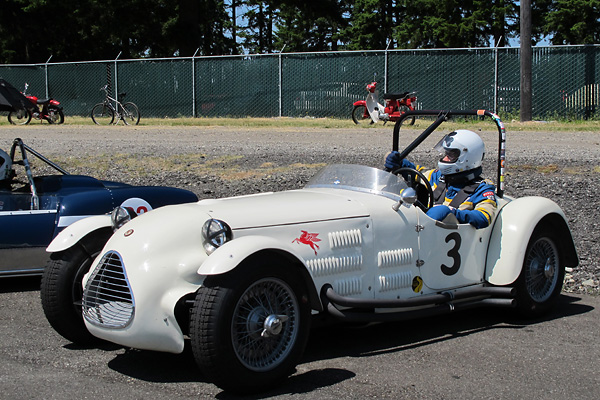
�
�
The Terry Buffum / Don Parkinson Jaguar XK-120 Special
� � Owner: Terry Buffum� City: Bend, Oregon
� Model: XK-120 Special
� Engine: Jaguar 3.8L six cylinder
� Race prepared by: John Buddenbaum�
�
The Dawn of Sportscar Racing in California
��
Los Angeles was a center of American car culture, especially in the years following WWII.�
Servicemen returning from the war were excited about the little cars of England and the�
"sportscar" concept took root. Sportscars were something apart from transportation�
appliances. Instead, people bought sportscars because they were fun to drive. They were�
also fun to race!�
�
As Hollywood thrived, so did a market for ever faster and more glamorous sportscars.�
Jaguar's Hollywood California dealership, International Motors, was among the best places�
to buy these new models. �
�
The dealer principal of International Motors was a man named Roger Barlow. �
Barlow was a racer, a founding member of the California Sports Car Club, a participant in�
the Cal Club's very first race, and a hard-core enthusiast. Barlow may be best remembered�
for hiring a young Phil Hill - first as a mechanic and then as a driver - and for�
keeping Hill in competitive cars until his professional driving career really took off.�
(Phil Hill was the first American to win a Formula One Drivers Championship. He also won�
the 24 Hours of LeMans three times.) Many other pioneers of American sportscar racing�
relied on Barlow's dealership: Richie Ginther, Stan Nowak, and others.�
�
Hollywood architect Don Parkinson, who had grown up with Phil Hill and married Hill's sister�
Helen bought one of the first Jaguar XK-120s available from International Motors. The�
International Motors shop prepared Parkinson's XK-120 for racing and maintained it between�
events. Later, International Motors mechanics rebuilt Parkinson's wrecked XK-120 with a�
custom-made body. This article is the story of Don Parkinson's rebuilt XK-120 and of the unique�
construction details which differentiate it from Jaguar's original design.�
�
�
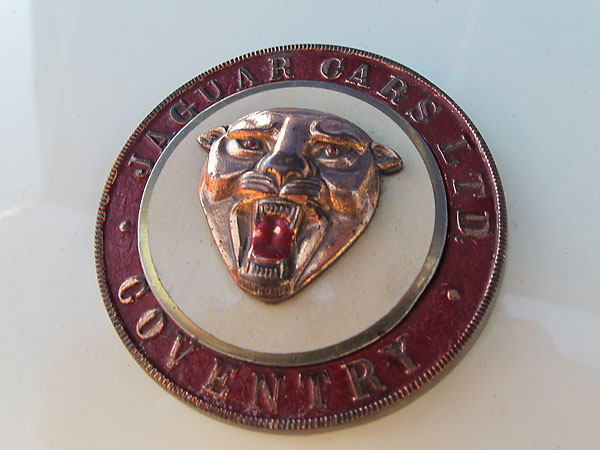
�
Jaguar Cars Ltd. - Coventry
�
Jaguar's XK-120 Model
��
London, October 1948: an exciting prototype appeared in the Jaguar Cars Ltd. booth at the�
Earls Court Motor Show. Before ramping up to full speed production, Jaguar offered the new�
XK-120 on a limited basis. The early version featured hand-built aluminum�
bodywork over ash wood framework. About 240 aluminum bodied XK-120s were built, and�
about 183 of those came with left-hand drive. In early 1950, production of steel bodied XK-120s�
kicked into gear. Steel bodied XK-120 production would reach 12,078 cars before the XK-120�
model was replaced in 1954. Both versions of the XK-120 featured 3.4L engines, four speed�
manual transmissions, uncommonly robust box-section steel frames derived from Jaguar's MarkV�
saloon model, torsion-bar front suspensions, Girling drum brakes all around, and steel disc�
wheels. ENV rear axles were originally used, but Jaguar switched over to Salisbury axles.�
In either case, all XK-120s came with live axles mounted on leafsprings.�
�
Early Racing Success - Parkinson and his XK-120 (SN: 670191)
��
Don Parkinson finished second at the first ever 100 mile road race at Pebble Beach. Only�
Phil Hill was quicker, and incidentally both drivers were piloting new Jaguar XK-120s.�
�
In a wintertime match-up at Carrell Speedway, Parkinson got partial revenge by beating�
Hill soundly. Hill finished fourth in a borrowed MG TC which had been re-powered with a�
Ford "60" V8.�
�
Parkinson was determined to win a proper rematch at Pebble Beach the following year,�
but in practice he pushed his Jaguar too hard and slid into a tree. For the main event,�
he borrowed an MG TD and finished third in the 1.5L class.�
| Date | Location | Finish | Notes | |
| November 5, 1950 | Pebble Beach | 2nd | 100 mile race. | |
| February 25, 1951 | Carrell Speedway | 1st | ||
| April 1, 1951 | Palm Springs | 4th | ||
| May 27, 1951 | Pebble Beach | DNF | Crashed, with substantial body damage. | |
Don Parkinson's Jaguar XK-120 Special
��
Immediately following the race at Pebble Beach, Parkinson's crumpled wreck was�
transported back to International Motors where it was stripped apart and carefully�
inspected. The frame could be straightened. The suspension could be repaired. The�
engine was okay... but the car would certainly need a whole new body. A decision�
was made to build a "special."�
�
The new body styling would be based on drawings made by a local teen-ager named�
Robert Cumberford, who later designed the famous Flying Shingle. (The Flying Shingle�
was an MG special racecar, circa 1955, built and raced by Ken Miles before he joined�
up with Carroll Shelby, but that's a whole different story.) After completing high�
school, Cumberford went on to General Motors as a designer on the Corvette team.�
Later Cumberford joined Automobile Magazine where he wrote about automotive design�
for many years.�
�
Joe Thrall is credited at the principal mechanic involved. Thall relocated the Jaguar engine�
rearward about twelve inches, downward about four inches, and slightly to the right of�
centerline. A custom aluminum body was constructed in-house by Marvin Faw.�
The net result was a slick new car, almost 1000 pounds lighter than a stock XK-120�
plus both lower and better balanced.�
�
�
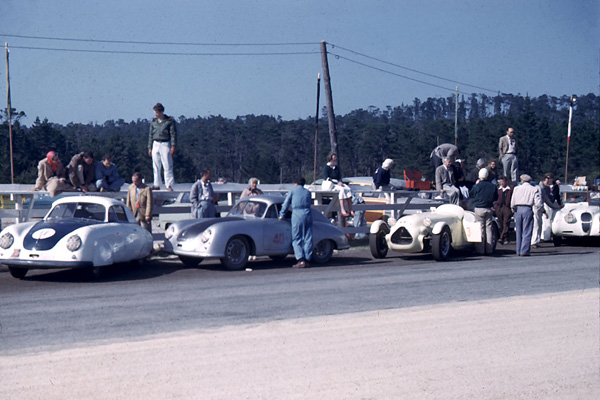
�
The Parkinson Special finished third overall and first in class at Pebble Beach, 1952.
�
(Note: the Porsches at left raced in the under-1.5L group. Both withdrew early with brake problems.
�
The silver one is a "Gmünd coupe" - one of the first fifty Porsches ever built - and more importantly
�
the very first Porsche to ever win a race in North America. After appearing at Pebble Beach in silver,
�
owner John von Neumann had the roof cut off and the body repainted red. At Torrey Pines in July it
�
won its class. Chuck Forge has owned and raced this historic car for many years.)
�
Don Parkinson / Parkinson Special Competition Results
�| Date | Location | Finish | Notes | |
| October 21, 1951 | Reno | 2nd | 1st in class. First race with special body. | |
| October 28, 1951 | Palm Springs | 1st | First race with spoked wheels. | |
| December 9, 1951 | Torrey Pines | 2nd | 1st in class. | |
| March 23, 1952 | Palm Springs | 2nd | ||
| April 20, 1952 | Pebble Beach | 3rd | 1st in class. | |
| May 31, 1952 | Golden Gate Park | 4th | 1st in class. | |
| July 20, 1952 | Torrey Pines | 3rd | ||
| November 9, 1952 | Madera | 5th | ||
| December 14, 1952 | Torrey Pines | 2nd | ||
| May 30, 1953 | Golden Gate Park | 3rd | Last known race of Don Parkinson's ownership. | |
�
�
For 1953, Don Parkinson decided to upgrade to a new Jaguar C-Type. The C-Type model was�
conceived specifically for racing. It featured a lightweight tubular frame, a more highly tuned engine,�
and from 1952 the C-Type featured disc brakes on all four corners. (Disc brakes were a very big�
improvement.) However, Parkinson wrecked his C-Type at Pebble Beach on April 19, 1953 - and�
on the very same corner that had vexed him in 1951. He soon sold his other car, the Parkinson�
Special and gave up racing. Don Parkinson committed suicide on September 30, 1955.�
�
The sequence of ownership after Don Parkinson isn't completely clear. In one order or another,�
the first three owners after Parkinson were Jay Bessemyer, Josie von Neumann, and Jay Chamberlain.�
Jay Bessemyer is known to have provided the Parkinson Special to Chuck Daigh to race (see below.)�
We also know from published race records that Josie Von Neumann was registered for but didn't arrive�
with a "Jaguar XK-120 Special" for the 4th Running of the Torrey Pines Road Races on July 4th 1954. �
Jay Chamberlain is marked as registered-for but did-not-arrive with a "Jaguar Special 3550cc" for�
March 26-27, 1955 races at Palm Springs and May 1, 1955 races at Bakersfield. Jay Chamberlain sold�
the Parkinson Special to Linus Bittner who in 1961 removed the Jaguar engine and substituted a 1953�
Cadillac V8. The Cadillac engine was better suited for drag racing, an in this configuration the car�
proved durable. After Linus Bittner tired of drag racing the car, he sold it to Kent Moore, and�
ultimately Moore sold it to a fraternity brother of a friend at USC: Al Gornick. These last two�
sales were both for $600. Through this period, the car endured quite a lot of drag racing!�
�
Chuck Daigh / Parkinson Special Competition Results
�| Date | Location | Finish | Notes | |
| October 3, 1953 / October 4, 1953 | Long Beach | 1st (S+1.5) / 4th (Sports) | Held at Reeves Field's "Terminal Island". | |
| February 7, 1954 | Palm Springs | 2nd | ||
| April 11, 1954 | Pebble Beach | 4th | ||
Terry Buffum's Stewardship
� �
Terry bought the Parkinson Special in 1970, and it sat while he had other projects. �
The Cadillac engine was still installed when Terry bought the car.�
In the mid-1970s Terry hired Marvin Faw to restore the car but Faw's failing health prevented�
completion. John Buddenbaum took over the project and completed the restoration in about 1982.�
Among other things, the restoration required fabricating a new bonnet (top section), creating�
new motor mounts, and building up a set of custom exhaust headers. Keeping the car period�
correct was a very high priority. For example, although disc brakes would provide a huge�
performance improvement, they'd be conspicuously "incorrect" for the car. �
�
Terry and John enjoy campaigning the car together. They've vintage raced it quite actively�
since 1983. John has driven the Parkinson Special in all its races since restoration,�
but Terry regularly drove the car to and from races into the 1990s. The Parkinson Special�
has proven an uncommonly reliable race car, with only three DNFs in the last twenty-five�
years whilst chalking up many victories and countless podium finishes in its class.�
�
Incidentally, John has a shop in San Carlos, California where he works on vintage racecars and�
does automotive fabrication work. One of his hobbies is building very customized motorcycles.�
John and a partner hold three world records on streamlined motorcycles at Bonneville. John has�
driven their 50cc motorcycle at 145mph! His partner, Eric Noyes, has piloted the same bike with�
larger displacement engines to 100cc and 125cc records. �
�
�
�
IMPORTANT ANNOUNCEMENT
�
BritishRaceCar.com will have to cut back plans for continued growth if we can't find more financial support.
�
If you like what you've found here, and you want to see more, please click here and follow the instructions.
�
Readers like you keep BritishRaceCar.com online and growing through voluntary financial contributions.
�
Features and Specifications
�| Engine: | �Jaguar 3.8L six cylinder engine,�
hopped up with oversize valves,�
forged pistons, �
stronger connecting rods,�
full race camshaft, etc.�
(~12.5:1 static compression ratio.)�
Warneford Design intake manifold.�
Triple Weber 45DCOE carburetors.�
Vertex magneto. �
| �
| Cooling: | �large copper/brass radiator. Aluminum oil cooler. | �
| Exhaust: | �custom fabricated six-into-two headers, by John Buddingbaum. | �
| Transmission: | �Moss Gears 4-speed manual transmission (synchronized on 2nd, 3rd, and 4th.)�
Cast aluminum bellhousing.�
Ten inch Borg & Beck style clutch.�
Ford master cylinder. | �
| Rear Axle: | �Salisbury 2HA housing. Welded differential. 3.54:1 final drive ratio. | �
| Front Susp.: | �standard torsion bar springs.�
Koni single-adjustable shock absorbers.�
Custom anti-sway bar. | �
| Rear Susp.: | �semi-elliptic 7-leaf leafsprings.�
Koni shock absorbers.�
Custom Panhard bar. | �
| Brakes: | �(master) 1952 Ford single-circuit master cylinder and pedal assembly. (No bias adjustment.) � (front) stock Jaguar (Girling) twin leading shoe Alfin drum brakes. � (rear) stock Jaguar (Girling) single leading shoe Alfin drum brakes. | �
| Wheels/Tires: | �Dunlop 70-spoke wheels.�
Blockley Tyre Company (5.50-16H front, 6.00-16H rear) 6-ply tires, custom shaved to suit racing. | �
| Electrical: | �Odyssey red battery.�
Lucas generator (installed, but no longer used.)�
Niehoff voltage regulator (installed, but no longer used). | �
| Instruments: | �(left to right)�
Stewart Warner fuel level gauge (E-F),�
water temperature gauge (100-265F),�
oil pressure gauge (0-100psi), and�
oil temperature gauge (140-325F).�
Smiths mechanical tachometer (0-6000rpm).�
| �
| Fuel System: | �regular steel fuel tank.�
Carter electric fuel pump (instead of S.U.)�
Rotary dial fuel pressure regulator. | �
| Safety Eqmt: | �Simpson 5-point latch-and-link safety harness.�
Centralized (10 pound) fire extinguishing system.�
Raydyot mirrors. | �
| Weight: | �~2100 pounds. | �
| Racing Class: | �Pre-1955 Modified | �
Engine Installation
��
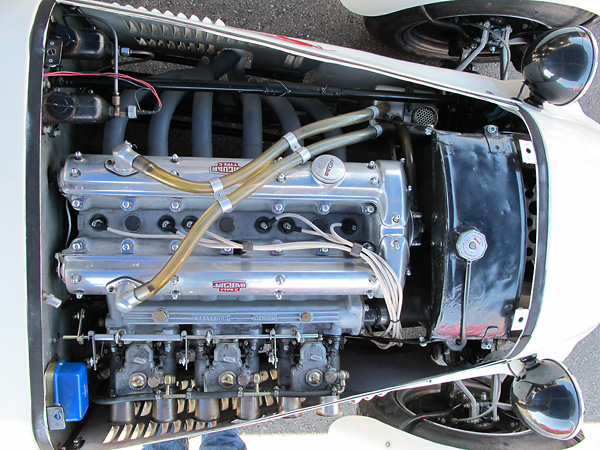
�
Jaguar 3.8L six cylinder engine, hopped up with oversize valves. Forged pistons and
�
stronger connecting rods are needed to support a compression ratio of about 12.5:1.
�
This car originally had a 3.4L engine, but in late 1952 it was bored out to 3.8L.
�
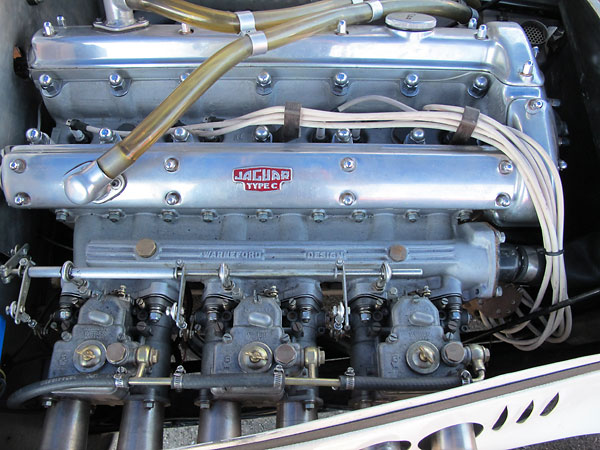
�
Driver John Buddenbaum reports that he revs this engine to about 6000rpm.
�
(The car isn't equipped with a rev-limiter.)
�
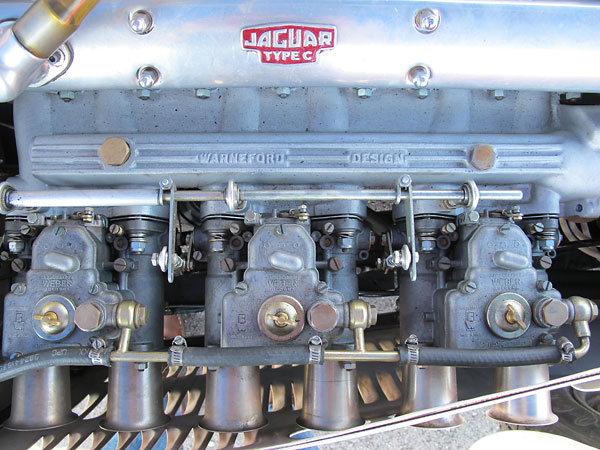
�
Warneford Design intake manifold supports triple Weber 45DCOE carburetors.
�
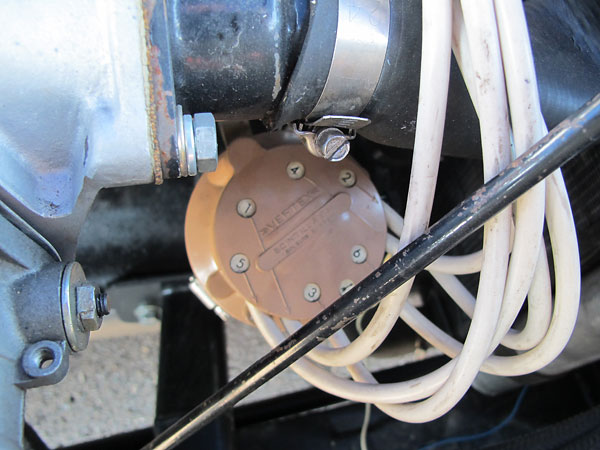
�
After about twenty years of service this Vertex magneto needed to be rebuilt.
�
Other than that, it's proven reliable and virtually maintenance free.
�
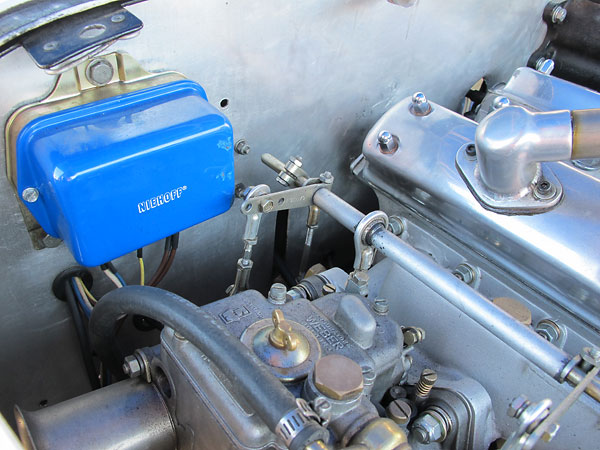
�
Niehoff voltage regulator. (This worked with the Lucas generator, which recently failed.)
�
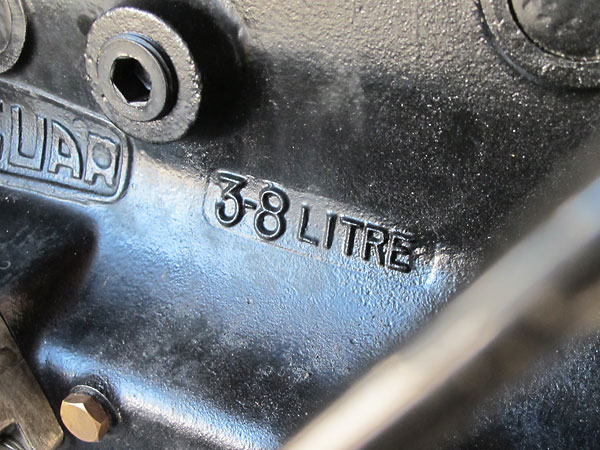
�
"3-8-Litre" on the block casting clearly indicates this is a replacement engine. The Parkinson Special was
�
originally built with a 3.4L engine (83mm bore by 106mm stroke). Introduced in 1958, the 3.8L version is
�
much more readily available. Jaguar achieved a ten percent increase in displacement by increasing
�
bore size to 87mm. The change was slightly complicated by a decision to begin installing dry liners.
�
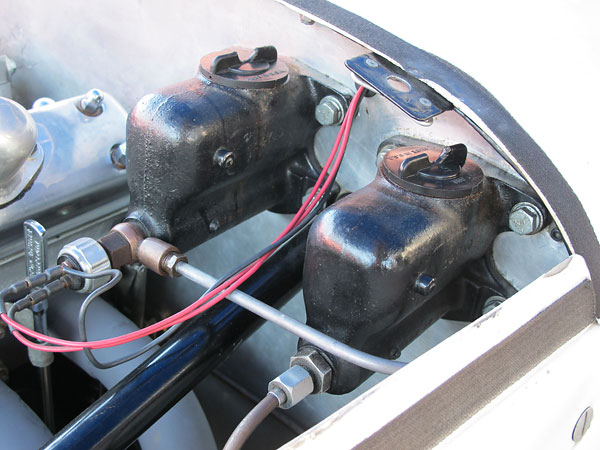
�
Both master cylinders are from Ford's 1952 model pick-up truck.
�

�
Dipstick: "Stop engine. Wait one minute."
�
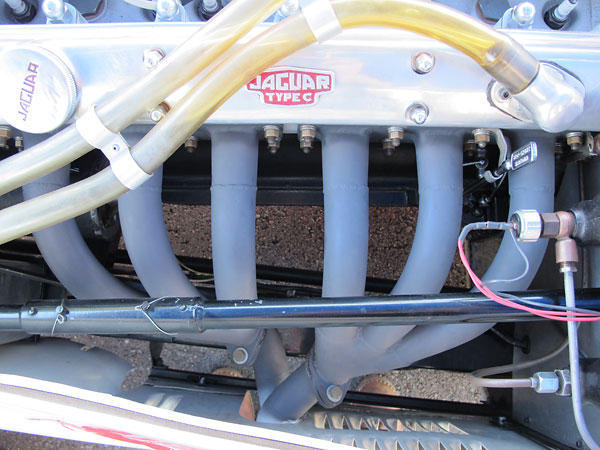
�
John Buddingbaum custom fabricated these six-into-two headers.
�
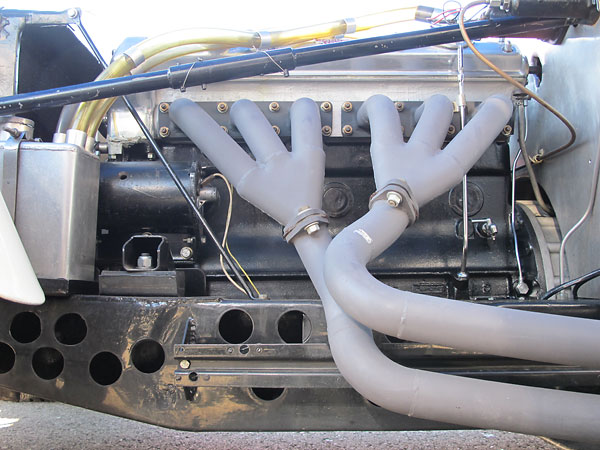
�
Lightening holes cut in Jaguar frame rails testify that mechanics at International Motors appreciated
�
the value of weight reduction. Each hole contributes only a modest reduction, but ultimately, the
�
Parkinson Special weighed about a thousand pounds less than the wrecked car it was built from.
�
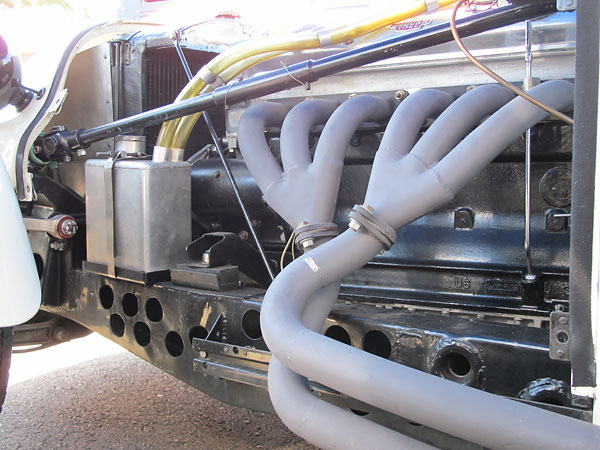
�
Another weight reduction opportunity lay in reserve. As magnificent is Jaguar's engine is, it's heavy.
�
Most engines that weigh over six hundred pounds offer substantially more displacement.
�
The original Jaguar engine was replaced with a 1953 Cadillac V8 sometime before 1957.
�
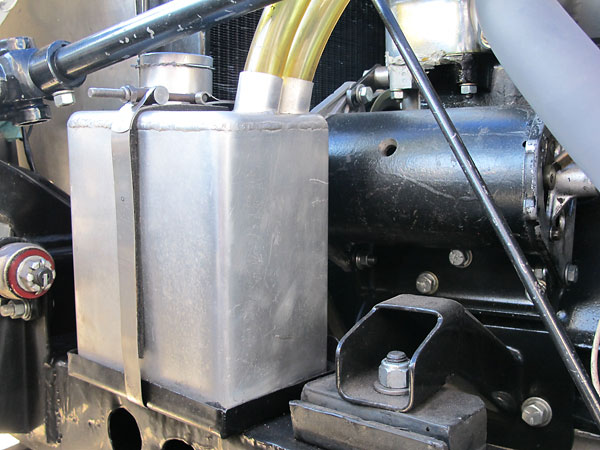
�
(foreground) A custom fabricated motor mount is required because the engine has been installed
�
rearward of the XK-120 position by about twelve inches, downward by about four inches, and
�
also slightly to the right of centerline to balance the driver's weight and provide him more room.
�
(background) The original Lucas generator caught fire and burned up. Expensive to replace...
�
Terry and John decided to gut it out, but keep it in place as a fan belt tensioner.
�
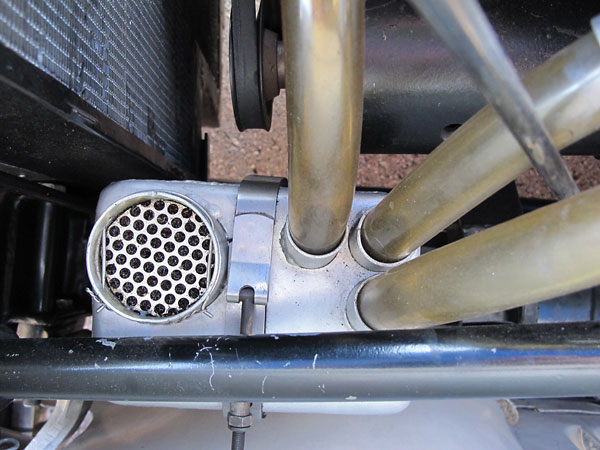
�
Custom fabricated aluminum crankcase breather tank.
�
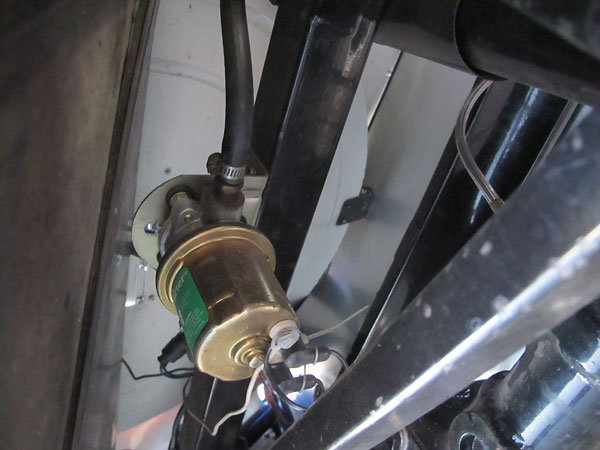
�
Carter electric fuel pump (instead of S.U.)
�
�
Front Suspension
��
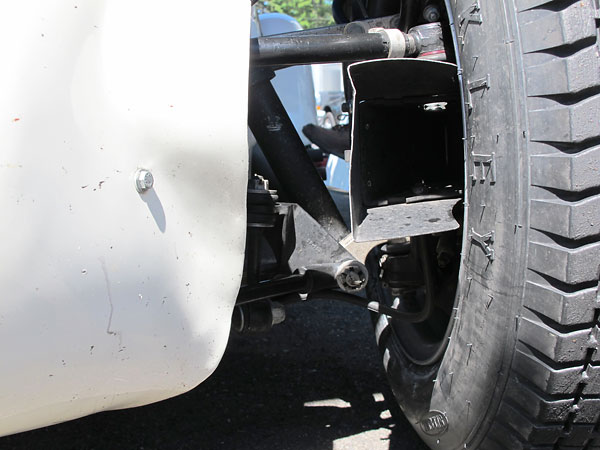
�
Brake cooling duct.
�
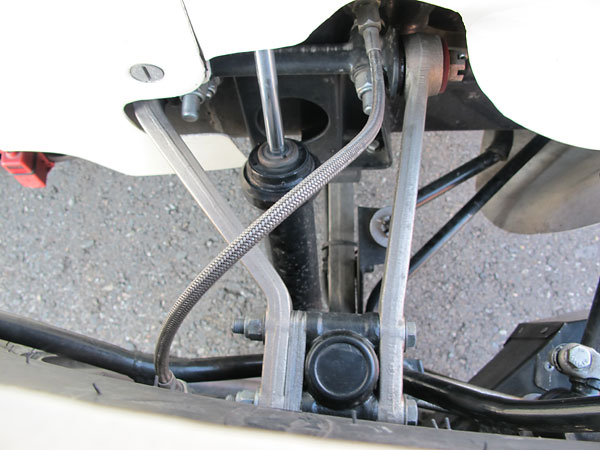
�
Both castor and camber are readily adjustable with simple, flat shims.
�
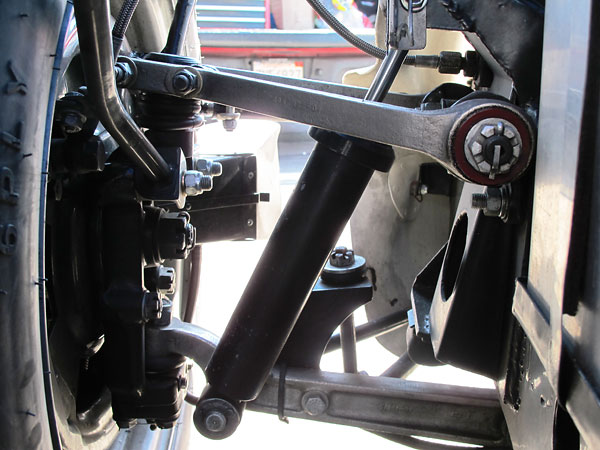
�
Original Jaguar XK-120s were equipped with black-painted Newton telescopic shock absorbers.
�
This is an older-model Koni adjustable shock absorber. (It must be removed for adjustment.)
�
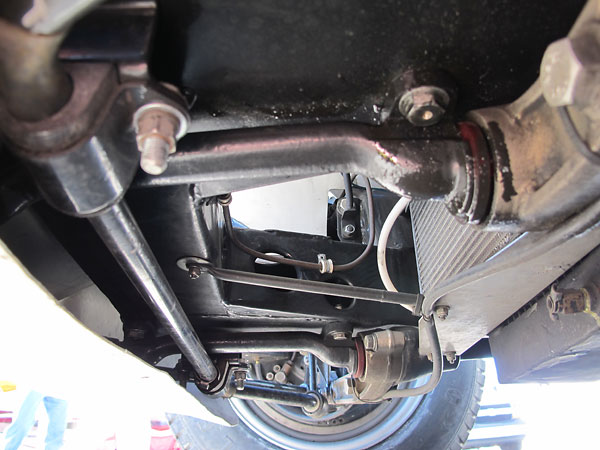
�
One advantage of Jaguar's torsion springs over most coil spring installations is they
�
make it relatively easy to adjust ride height and static loading (i.e. "corner weights".)
�
Note also: hefty anti-sway bar and that an oil cooler is mounted in front of the radiator.
�
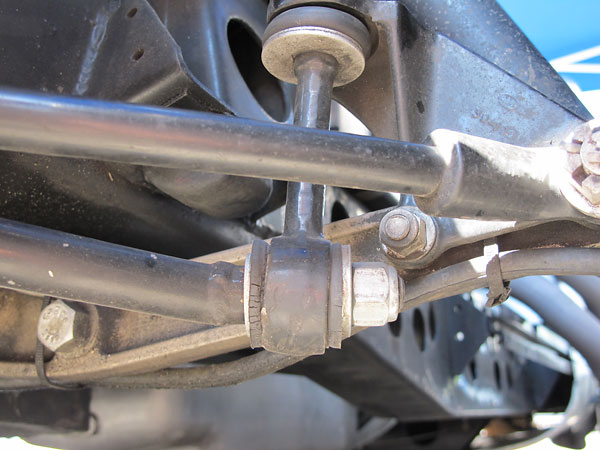
�
Anti-sway bar connection.
�
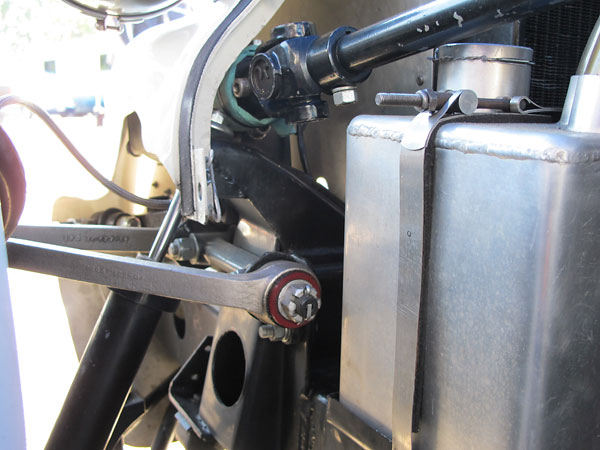
�
Location of the Burman reciprocating ball steering gear. (31' turning circle, 2.25 turns lock to lock.)
�
(Jaguar specified an Alford & Alder rack-and-pinion system, for the XK-140.)
�
�
Enjoying this article? www.BritishRaceCar.com is partially funded through generous support from readers like you!
�
To contribute to our operating budget, please click here and follow the instructions.
�
(Suggested contribution is twenty bucks per year. Feel free to give more!)�
Rear Suspension
��
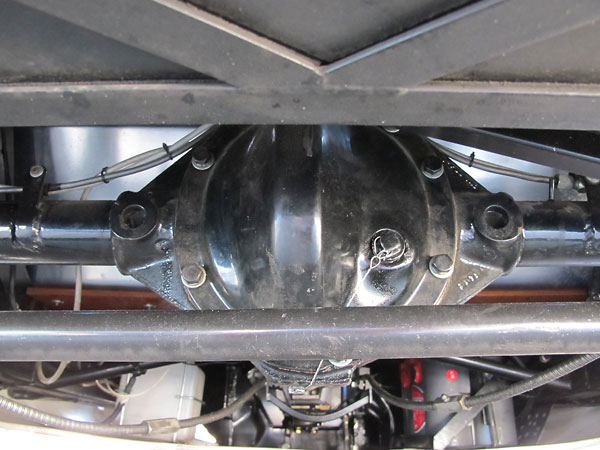
�
Early (aluminum-bodied) Jaguar XK-120s were built with ENV banjo style axles. At some point the
�
Parkinson Special has been updated to a Salisbury 2HA axle housing as used on later XK-120s.
�
(3.77, 4.09, and 4.27 were factory offerings but other ratios are available.)
�
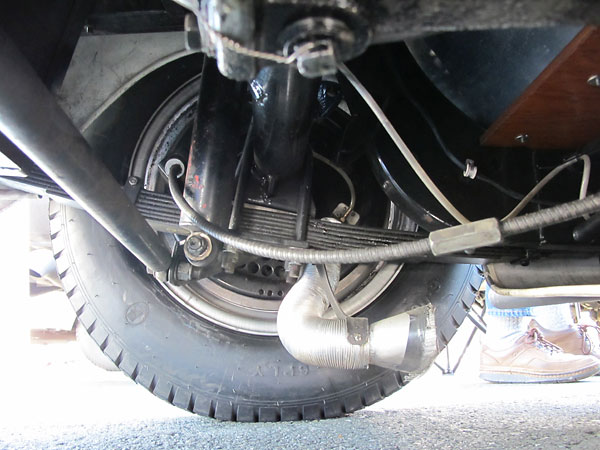
�
Semi-elliptic 7-leaf leafsprings and Koni shock absorbers.
�

�
A stout custom Panhard rod restricts side-to-side movement and also defines the body's
�
roll center. (With Panhard rod installed, the roll center is about four inches lower than original.)
�
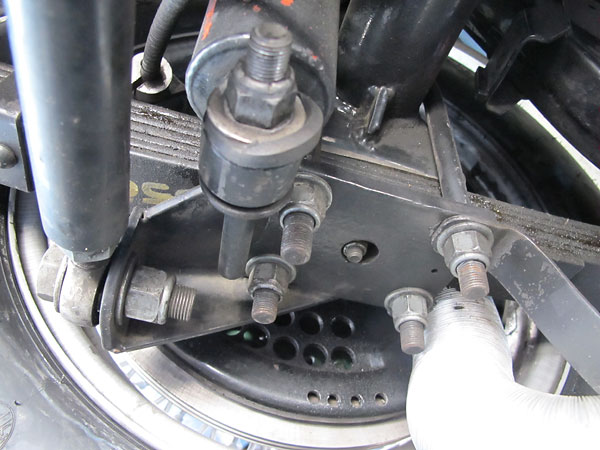
�
At one end the Panhard rod is attached to the axle.
�
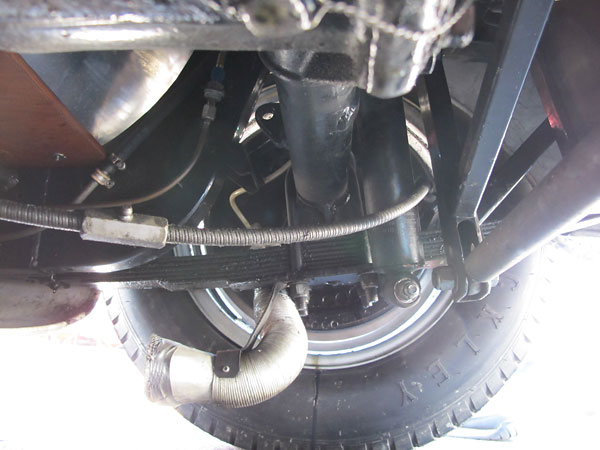
�
At its opposite end, the Panhard rod is attached to the frame of the car.
�
�
Interior
��
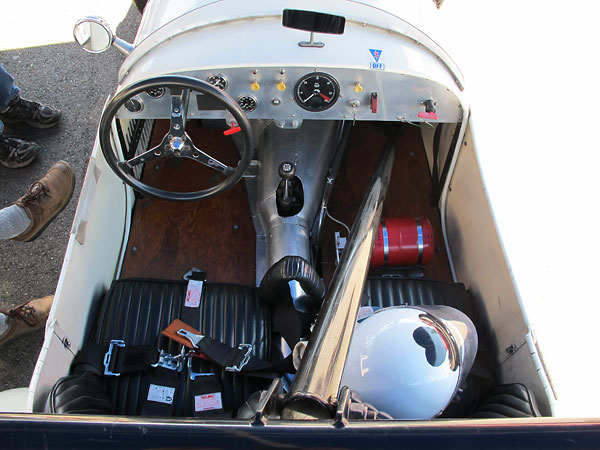
�
As originally raced, the Parkinson Special didn't have either seat belts or a roll hoop.
�
It didn't have a fire extinguisher or a master engine kill / battery cut-off switch either.
�
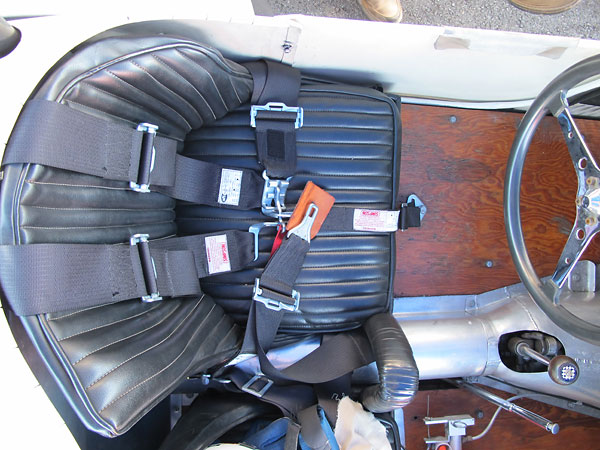
�
Simpson 5-point latch-and-link safety harness.
�
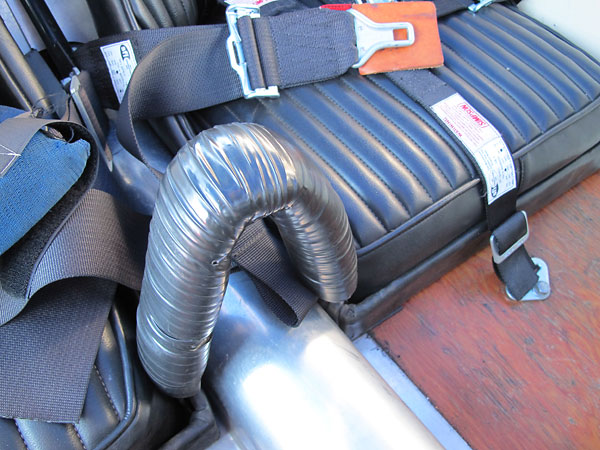
�
This padded brace helps John avoid sliding around in the cockpit.
�
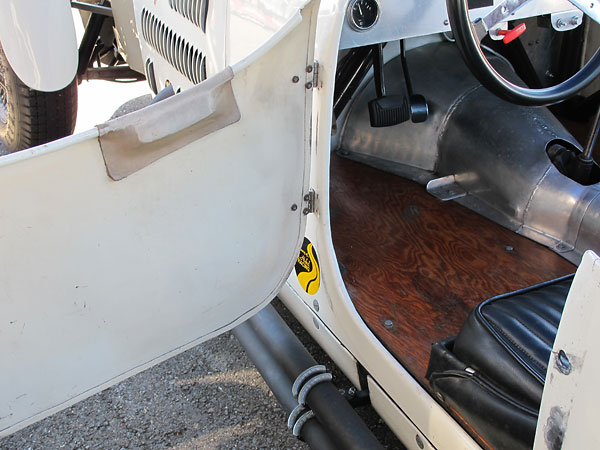
�
Knee pad.
�
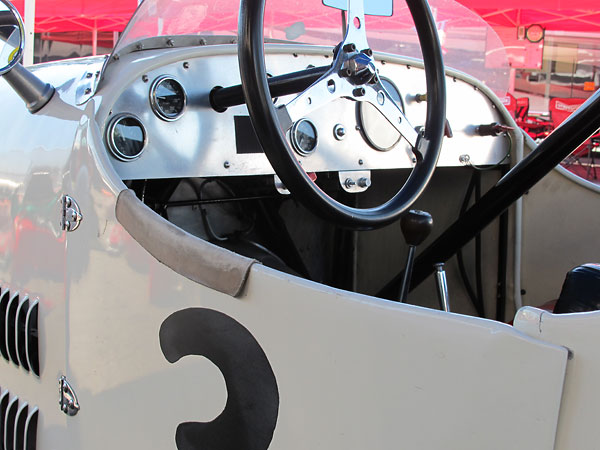
�
The leather cover of the knee pad wraps over the top of the door.
�
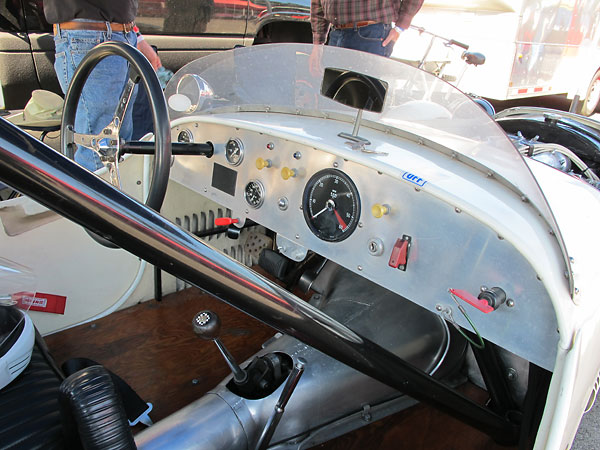
�
The roll hoop was built to provide clearance over the helmet of owner Terry Buffum.
�
It could probably be lowered ~1.5" and still protect driver John Buddingbaum.
�
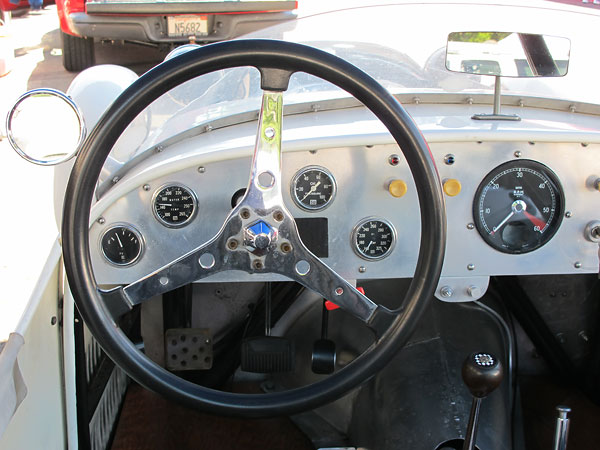
�
(left to right) Steward Warner fuel level, water temperature, oil pressure, and
�
oil temperature gauges. Cable-driven Smiths tachometer.
�
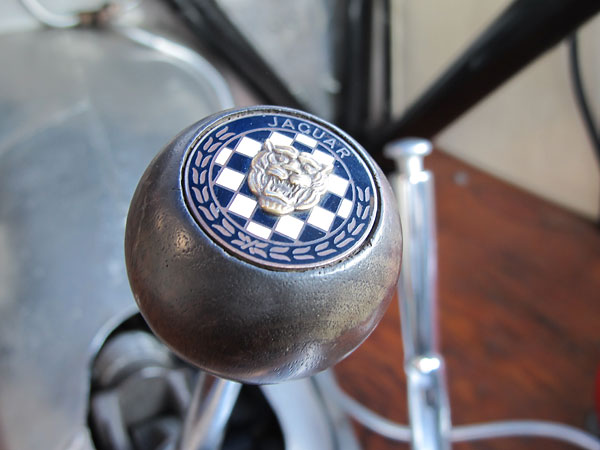
�
Jaguar-logo walnut shifter knob.
�
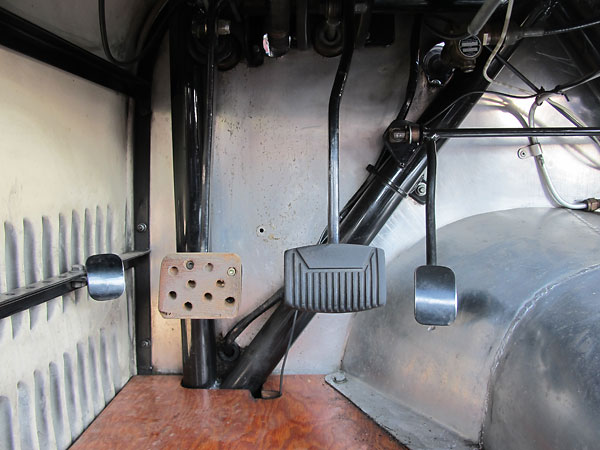
�
Elegantly simple pedal installation, including a dead pedal at left.
�
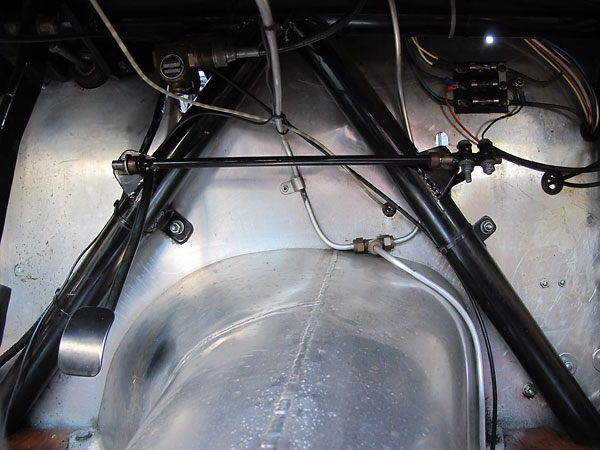
�
Throttle linkage.
�
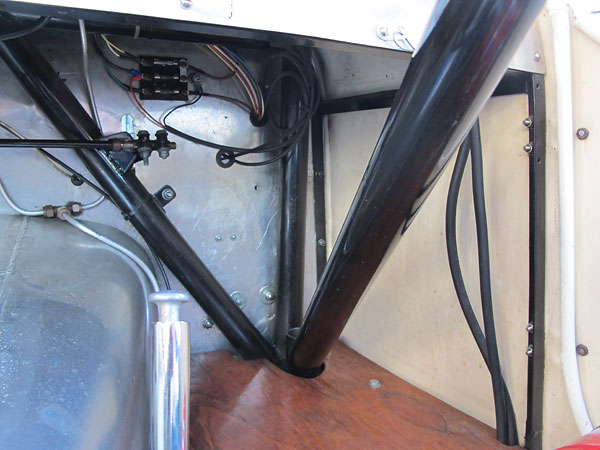
�
Roll hoop brace connection to frame rail.
�
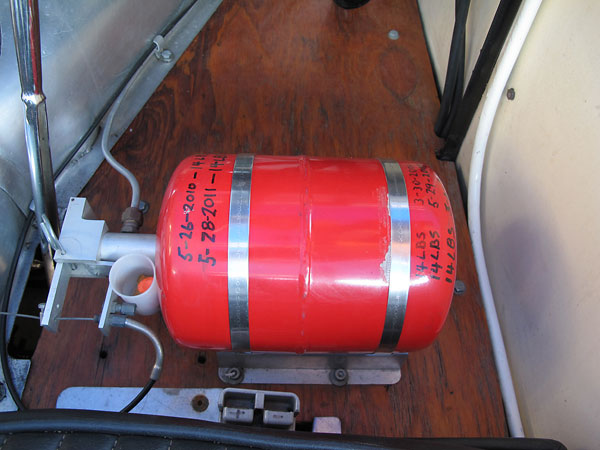
�
Ten pound fire extinguisher bottle. (14 pounds gross weight.)
�
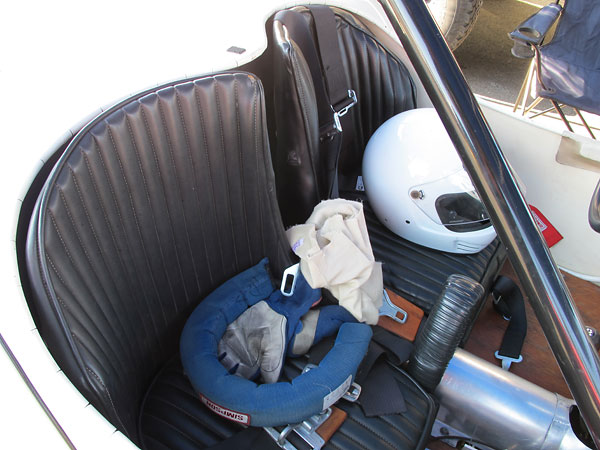
�
Generous passenger accommodations.
�
�
Exterior
��
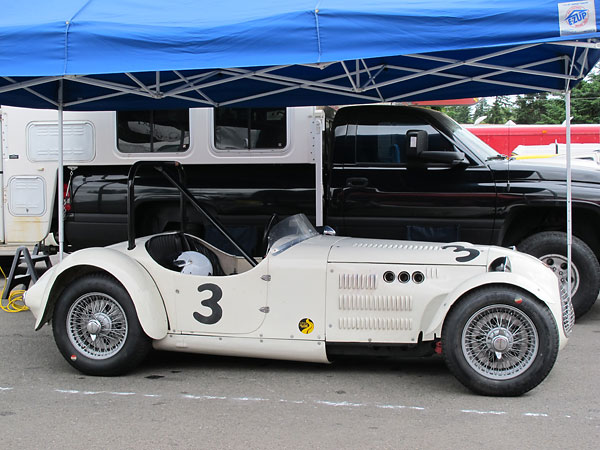
�
The Parkinson Special's body was designed by Robert Cumberford, who is also credited with the styling
�
of Ken Miles' famous "Flying Shingle" MG Special. The Parkinson Special's belly-pan is uninstalled
�
in our photos because it makes some maintenance operations somewhat less convenient.
�
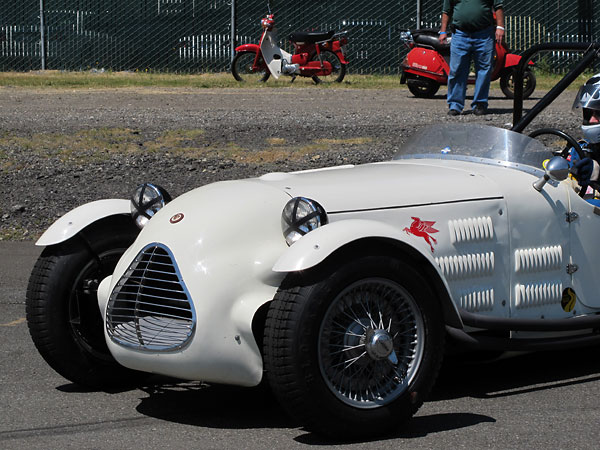
�
Grille styling was probably influenced by Allard. (No one denies that.)
�
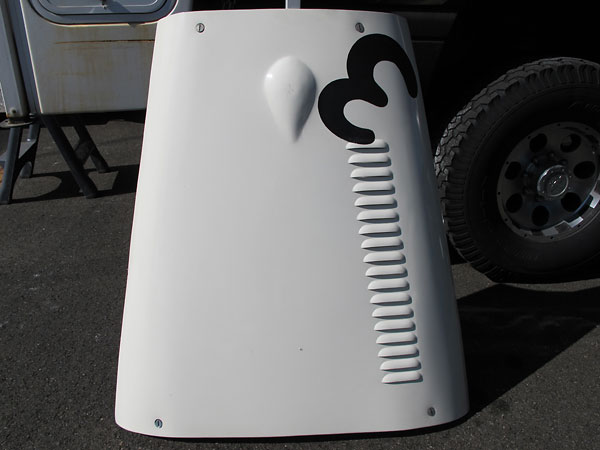
�
The original bonnet was missing at time of purchase. Working from photos, John Buddingbaum
�
handcrafted this aluminum replacement. He also fabricated replacement "motorcycle" fenders.
�
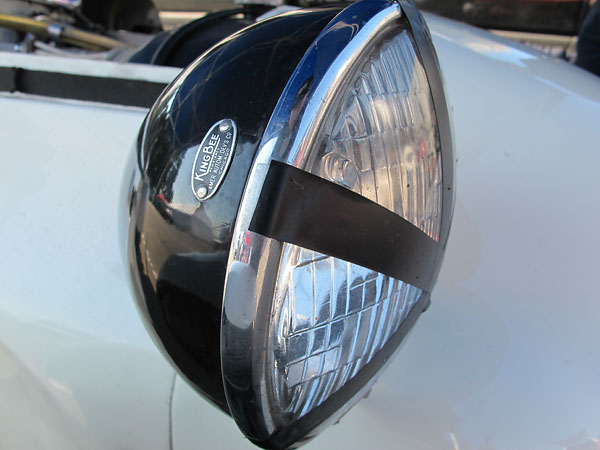
�
King Bee headlights from American Automatic Devices, Chicago Illinois.
�
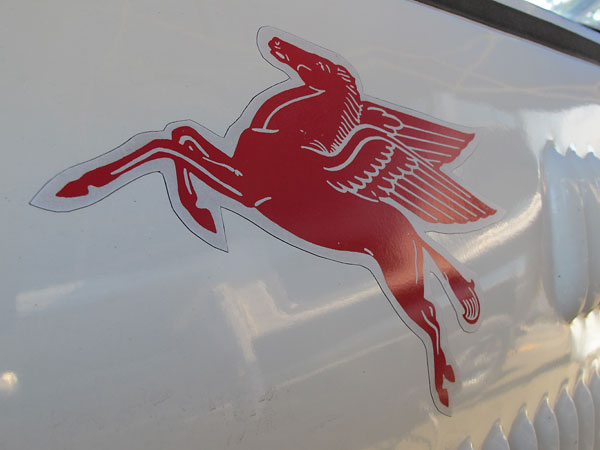
�
Pegasus.
�
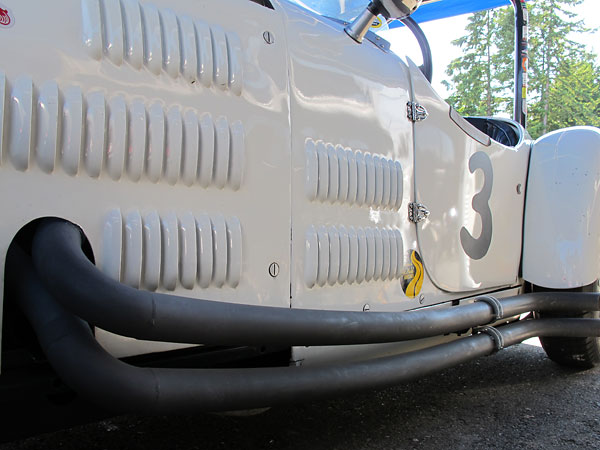
�
Avant garde styling.
�
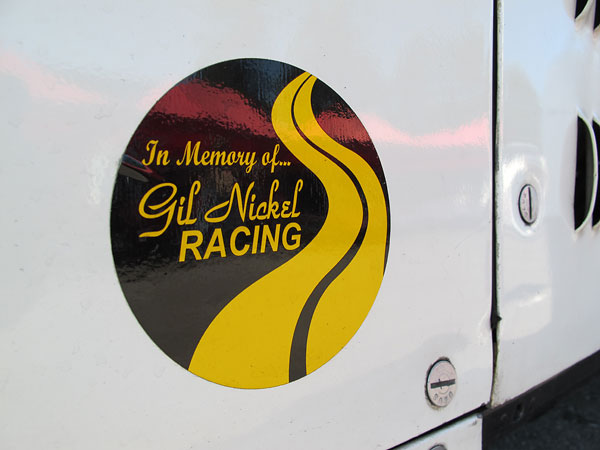
�
Decal: In the Memory of Gil Nickel Racing.
�
Beyond vintage racing, Gil Nickel was a Napa Valley winemaker.
�
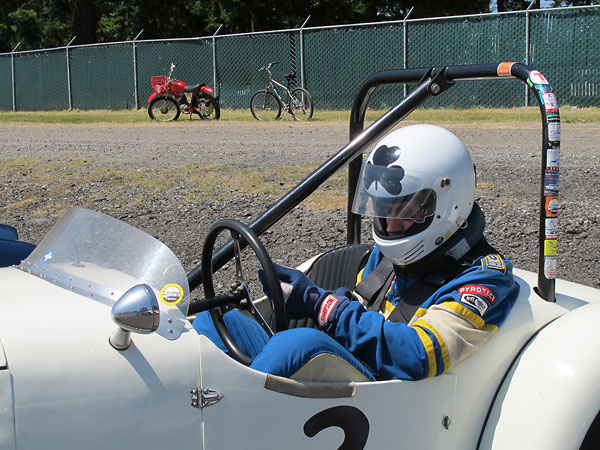
�
Legroom isn't exactly what one would call "generous".
�
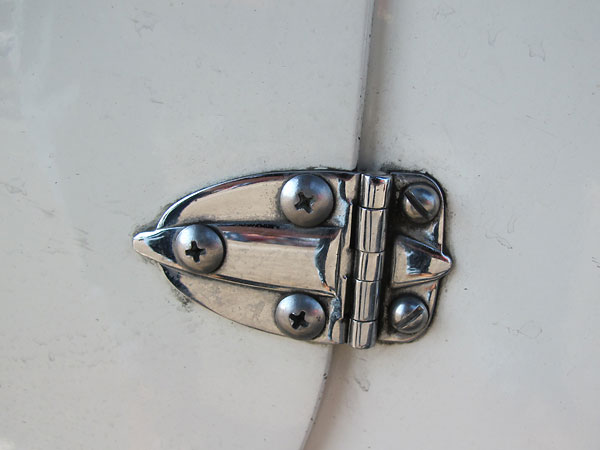
�
Exotic lightweight vintage racecar door hinges...
�
and they add just the right amount of flash!
�
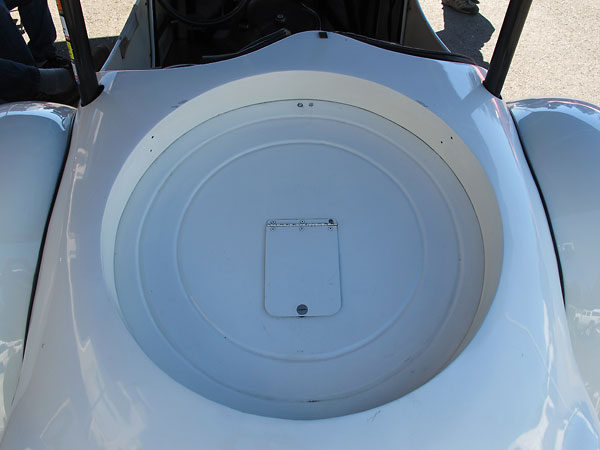
�
Recess for a spare wheel, although a spare has never been required for sprint racing.
�
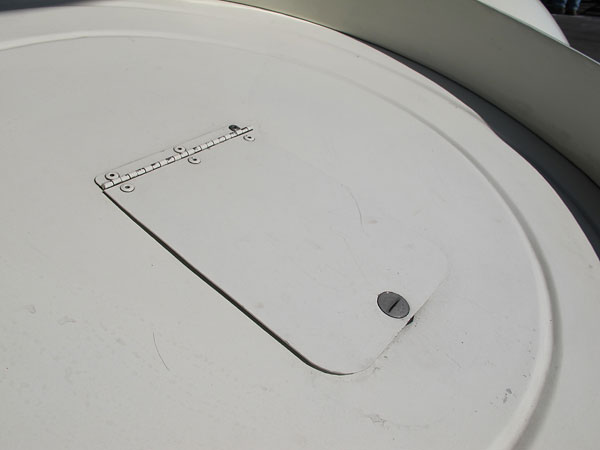
�
Fuel filler access lid.
�
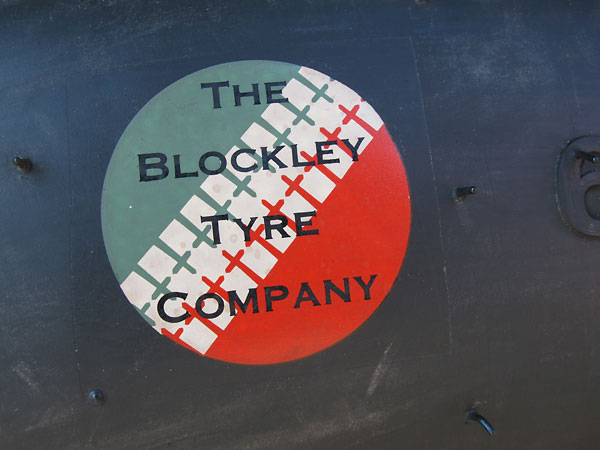
�
The Blockley Tyre Company.
�
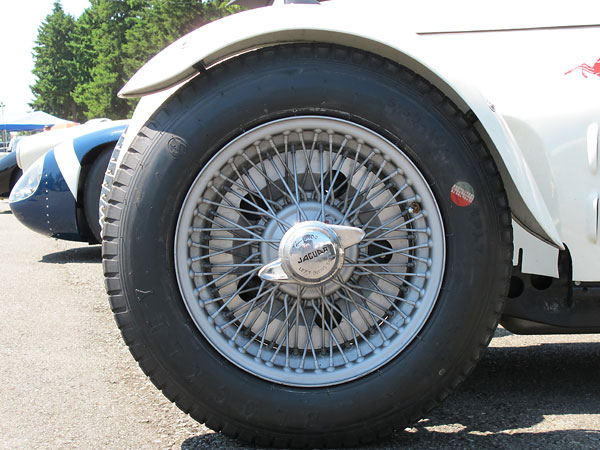
�
Dunlop 70-spoke wheels are used to help cool the Al-fin brake drums.
�
Steel disc wheels were original, replaced by Borrani spoked wheels in late 1951.
�
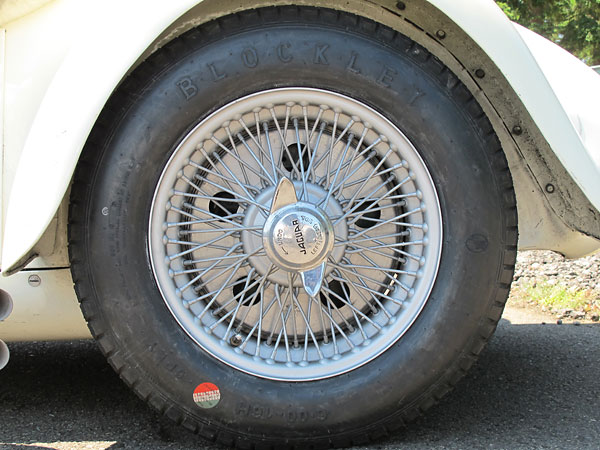
�
Blockley 6-ply tires (5.50-16H front, 6.00-16H rear), custom shaved to suit racing.
�
(This was the team's first outing with Blockley tires. Previously, the team has run Dunlops.)
�
�
Except for the vintage photo from Pebble Beach (circa 1952) all photos shown here are from�
June 2011 when we viewed the car at The Pacific Northwest Historics at Pacific Raceways�
in Kent, Washington. All photos by Curtis Jacobson for BritishRaceCar.com, copyright 2011.�
All rights reserved.�
�
The Pebble Beach photo is from Tery Buffum's collection, and is used here by exclusive permission.�
| If you liked this article, you'll probably also enjoy these: | �|||||
 | �
Dan Leonard '49 MG TC Special | �
 | �
Bob Millstein '51 XK-120 Special | �
 | �
Tivvy Shenton '55 Jaguar XK140 | �
| You're invited to discuss anything you've seen here on The British Racecar Motorsports Forum! | �|||||
�
Notice: all the articles and almost all the photos on BritishRacecar.com are by Curtis Jacobson.
�
(Photos that aren't by Curtis are explicitly credited.) Reproduction without prior written permission is prohibited.
�
Contact us to purchase images or reproduction permission. Higher resolution images are optionally available.
�

 �
�
 �
�